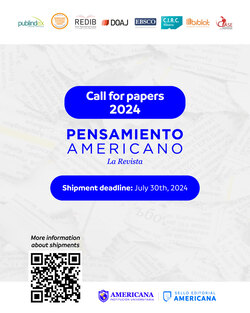Reading of the context for the design and operation of a Digital Writing Center in high education
DOI:
https://doi.org/10.21803/pensam.v12i24.307Keywords:
Educación básica; escritura; informática educativaAbstract
The process of designing an Online Writing Center (OWC) for high education must respond to global and regional challenges, however, knowing the context where it is going to be established is fundamental. The foregoing, because an OWC is not a distant issue to the realities of the institutions. The purpose of this article is to present the results on reading the context of two institutions that offer high education, one public and one private, that participated in the research process. For this, the case study was adopted and questionnaires of inquiry were applied to students and teachers, from the possibilities of design and operation of the CED in the high education and the conformation of a Virtual Learning Community. The results show how the information obtained was considered for the disposition of the OWC of each of the institutions. The conclusions state that reading the institutional context is important when thinking about the structuring and operation of an OWC for secondary education.
Downloads
References
Aguiar, D., Verdún, N., Silin, I., Capuano, A. & Aristimuño, F. (2014). Las TIC en la educación media: ¿una herramienta más o nuevo contexto de aprendizaje? Análisis de las representaciones de docentes y directivos sobre el Programa Conectar Igualdad en tres provincias de la Patagonia Argentina. Magistro, 8 (15), 19-58.
Al Murshidi, G. & Al Abd, K. (2014). UAE University Students’ Awareness of Using the Writing Center. Higher Education Studies, 4(3), 58-63. http://dx.doi.org/10.5539/hes.v4n3p58
Archer, A. (2008). Investigating the impact of Writing Center intervention on student writing at UCT. South African Journal of Higher Education 22(2), 248–264.
Cabero Almenara, J. (2013). El aprendizaje autorregulado como marco teórico para la aplicación educativa de las comunidades virtuales y los entornos personales de aprendizaje. Teoría de la Educación: Educación y Cultura en la Sociedad de la Información, 14(2), 133-156.
Caldevilla Domínguez, D. (2010) Las Redes Sociales. Tipología, uso y consumo de las redes 2.0 en la sociedad digital actual. Documentación de las Ciencias de la Información, 33, 45-68.
Calle Álvarez, G. Y. (2015). Revisión teórica y empírica sobre las Comunidades Virtuales de Aprendizaje (CVA). Revista Horizontes Pedagógicos, 17(1), 82-93.
De Gouveia, L. (2012). Comunidades virtuales y el aprendizaje estratégico de cálculo en ingeniería virtual. Pixel- Bit. Revista de Medios y Educación, (40a), 101-113.
Faigley, L. (1998). Writing centers in times of whitewater. The Writing Center Journal, 19(1), 7-18.
Flórez, R. & Gutiérrez, M. (2011). Alfabetización académica: una propuesta para la formación de docentes universitarios. Bogotá, Colombia: Universidad Nacional de Colombia.
García, N. (2005). Las comunidades de aprendizaje. Monográficos Escuela, 18, 1-10.
Harris, M. (1992). The writing center and tutoring in WAC programs. Writing across the curriculum: A guide to developing programs, 109-122. Recuperado de https://wac.colostate.edu/books/mcleod_soven/chapter10.pdf
Sampieri, R., Fernández Collado, R. & Baptista Lucio, P. (2010). Metodología de la Investigación. México: Mc- Graw-Hill, 5ta Edición.
Hewett, B. L. (2010). The online writing conference: A guide for teachers and tutors. Boynton/Cook.
Holtz, E. V. (2014). Mode, Method, and Medium: The Affordance of Online Tutorials in the Writing Center. Honors Scholar Theses 357, Universidad de Connecticut, Estados Unidos. Recuperado de: http://digitalcommons.uconn.edu/cgi/viewcontent.cgi?article=1352&-context=srhonors_theses
Hueso González, A. & Cascant i Sempere, J. M. (2012). Metodología y técnicas cuantitativas de investigación. Valencia, España: Editorial Universidad Politécnica de Valencia.
Molina Natera, V. (2015). Estudio de caso: Centro de Escritura Javeriano PUJ Cali. En: Molina Natera, V. (Editora).
Panorama de los centros y programas de escritura en Latinoamérica. Pontificia Universidad Javeriana, Cali, p. 276-311 Recuperado de: http://vitela.javerianacali.edu.co/bitstream/handle/11522/8091/Libro_Panorama_Centros_Esc_completo.pdfsequence=1&isAllowed=y
Nuñez, J. (2013). Una aproximación a los centros de escritura en Iberoamérica. Legenda, 17(17), 63-102.
Olson, G. A. & Smith, J. B. (1984). Establishing a writing center in high school. Journal of Teaching Writing, 3(1), 53-62.
Palacio, K. (2010) Re-centering Students’ Attitudes About
Writing: A Qualitative Study of the Effects of a High School Writing Center. Master's thesis. Nova Southeastern University. Retrieved from NSUWorks, Farquhar College of Arts and Sciences. Recuperado de: http://nsuworks.nova.edu/writing_etd/2.
Stueart, K. C. (2012). A Proposal for a Writing Center and a Peer Tutor Training Course at Fayetteville High School. (Tesis de Maestría). Universidad de Arkansas, Estados Unidos. Recuperado de: http://scholarworks.uark.edu/cgi/viewcontent.cgiarticle=1284&context=etd
Tan, B. H. (2011). Innovating writing centers and online writing labs outside North America. The Asian EFL Journal Quarterly, 13 (2), 390-417.
Utne, K. L. (2016). A Proposal for A Writing Center at Lafayette High School. Senior Honors Projects. Paper 204. Recuperado de:
Waller, S. C. (2002). A Brief History of University Writing Centers: Variety and Diversity. New Foundations. Recuperado de: http://www.newfoundations.com/History/WritingCtr.html
Werner, C. L. (2013). Constructing Student Learning through Faculty Development: Writing Experts, Writing Centers, and Faculty Resources. CEA Forum, 42(2), 79-92.
Williams, J. & Severino, C. (2004) The writing center and second language writers. Journal of Second Language 39 Writing, 13, 165-172.
Downloads
Published
Versions
- 2019-07-30 (2)
- 2019-07-21 (1)
Issue
Section
License
Copyright (c) 2019 Pensamiento Americano

This work is licensed under a Creative Commons Attribution-NonCommercial-NoDerivatives 4.0 International License.
The author or authors of an article accepted for publication in the Journal Pensamiento Americano will transfer all of the patrimonial rights to the American University Corporation free of charge, within which are included: the right to edit, publish, reproduce and distribute both print media as digital, in addition to include in article in international indexes and / or databases, likewise, the Editorial Seal is authorized to use the images, tables and / or any graphic material presented in the article for the design of covers or posters from the same magazine. By assuming the patrimonial rights of the article, it may not be partially or totally reproduced in any printed or digital media without its express permission.
AUTHORITY ASPECTS
For the Pensamiento Americano Journal, all the authors of an article have made substantial contributions to the research and the manuscript, and they share the responsibility when the article presents errors, fraud in some way or violations of copyright.
After submitting an article, the journal does not accept the addition, deletion or change in the order of the authors, in addition we reserve the right to release the article when it has been submitted to the journal and under no circumstances will American Thought accept the article. withdrawal of an article during any phase of the editorial process






